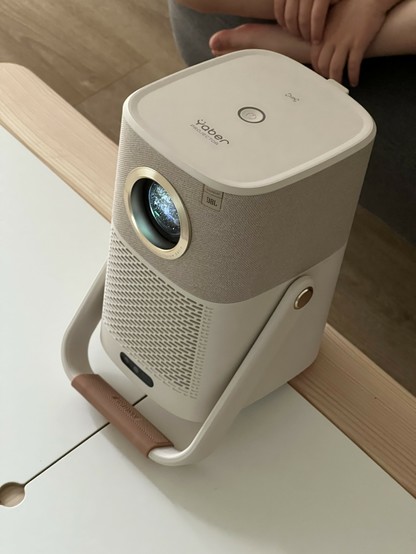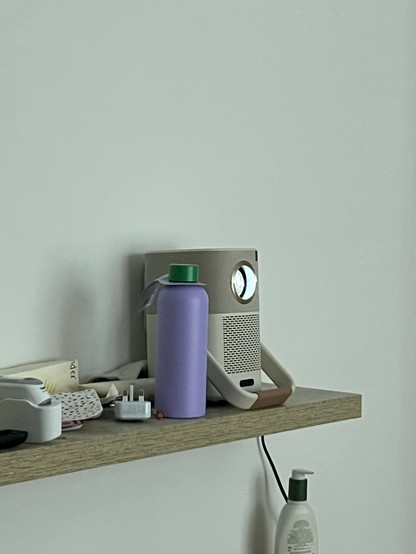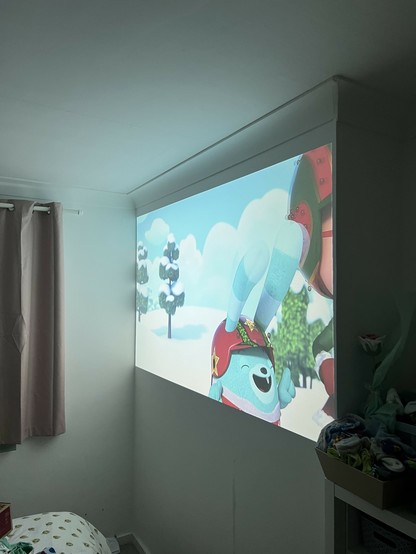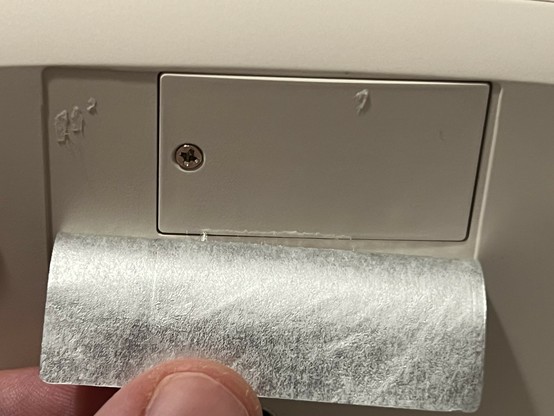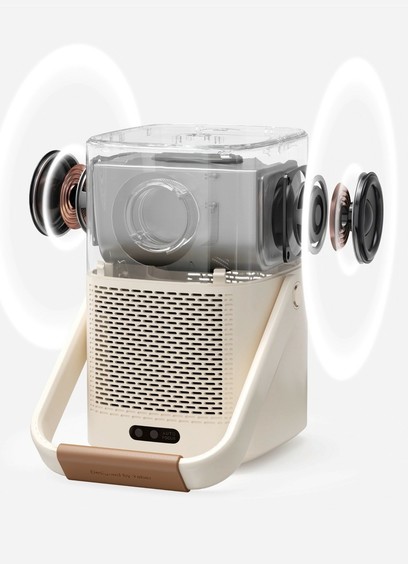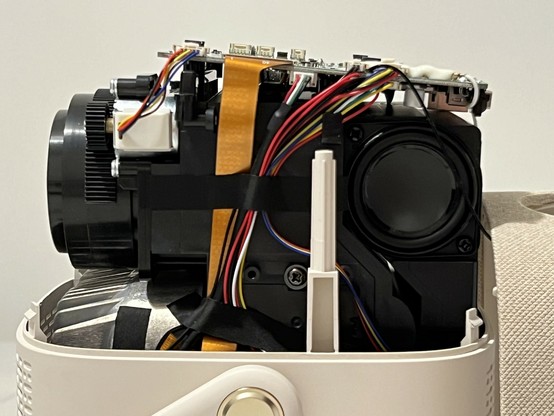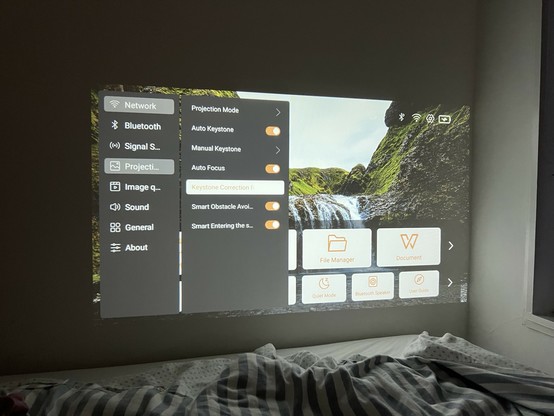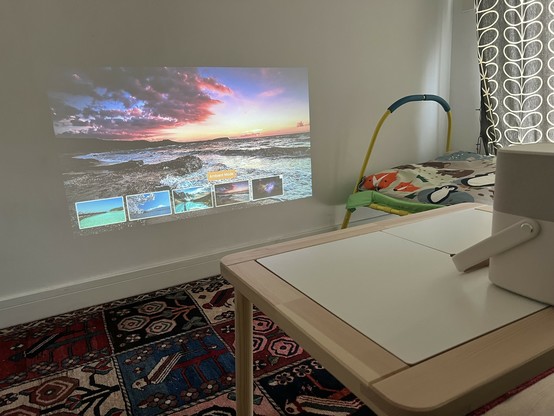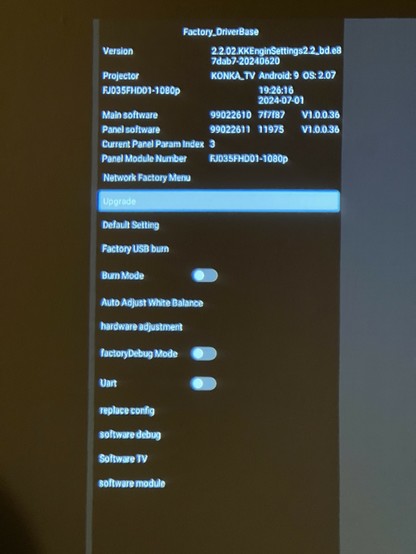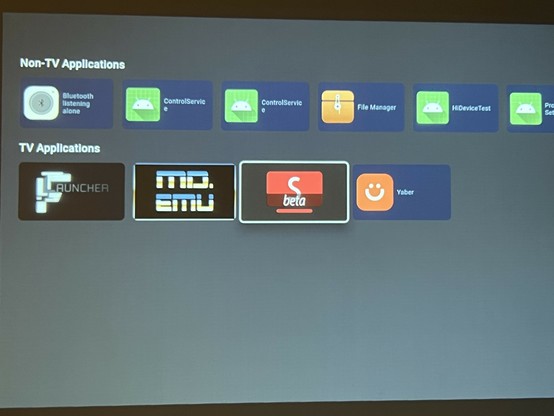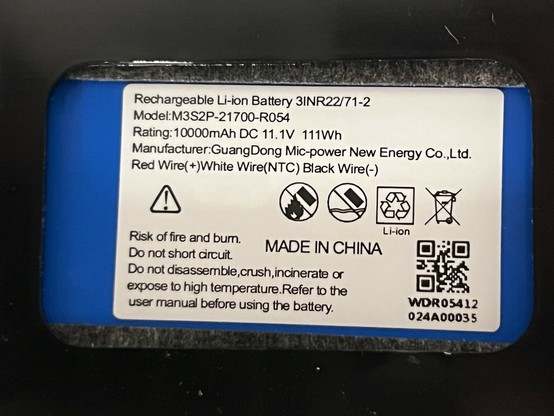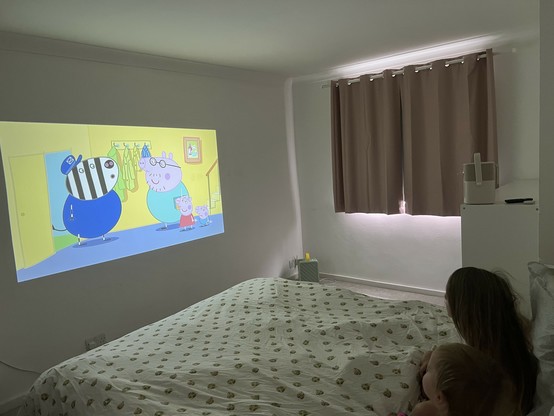Yaber T2 Plus Projector
I wasn’t expecting much from the Yaber T2 Plus, so it would be wrong to say it exceeded my expectations. It’s more fitting to exclaim that it both surprised and impressed me. That’s not to say it’s a particularly remarkable projector, but it does pack a very comprehensive set of features at what I’m given to believe (but don’t have confirmed yet) will be a reasonable price.
It’s a nice looking projector!
“What are these features?” I hear you ask. “Yes,” I reply. In short Yaber’s T2 packs a battery, auto keystone, auto focus, obstacle avoidance, wireless connectivity, media playback and pretty good looks all into a… well actually quite surprisingly large package.
The T2 Plus adds Android TV by means of a janky but fully functional external dongle, which is plugged into (and, thankfully, powered by) the HDMI port via a right-angled adapter. It hangs out of the back of the projector somewhat awkwardly and may be a tempting distraction for tiny fingers. Having the dongle as an optional extra means you can opt for a Fire TV, Roku, Raspberry Pi, or whatever else you might prefer as your media source and save a few bucks in the process. The supplied Android TV dongle is- as far as I can tell- absolutely vanilla and full featured, and is set up via the Google Home app just like a real Google-branded device (I assume anyway, I have a Fire TV) would be. Since the Android TV add-on works exactly as you might expect I’m not going to waste words delving into specifics. I will, however, say that Yaber added their smiley face logo to the right-angle HDMI adapter and it’s a super cute touch. Also, despite taking power from HDMI the dongle has a microUSB connector, so you can use it with other HDMI devices if you’re so inclined.
Regrettably the bedroom got moved around and this shelf was taken down. The throw angle is good enough to get a square picture from a bookcase next to the bed though!
Aside from the Android dongle and the accompanying, upgraded remote, both T2 and T2 Plus are identical. They share the same large, tall design which feels a little like a coolbox but looks a lot nicer. Yaber have gone for a beige colour with roughly the top two fifths looking like a premium fabric-wrapped speaker, and the bottom three being occupied mostly by a large front and back air vent. A little JBL logo cuts into the corner of the top section, albeit I don’t find the sound terribly impressive (more on that later). At the very bottom front are the autofocus camera and something that looks suspiciously like an infra-red sensor- additional front IR for the remote, perhaps? Around the back are a USB port, HDMI port, 3.5mm audio output, a hole for a reset pin, an IR sensor, and rather perplexingly an Ethernet port. The juxtaposition of “portable” and Ethernet is a strange one, but if you did want to fix the T2 to your ceiling, or use it semi-permanently in an office, at least you can be sure of a reliable network connection.
Before we get into software, my biggest complaint with the T2 as a piece of hardware is the figure-eight (C7) connector for power. In brief this means the projector has 240v (in the UK, at least) going directly into it, necessitating onboard power regulation and feeling just a little bit sketchy for something intended to be used outdoors, at parties, around kids. I would have taken a low(er) voltage barrel jack connector to move that C7 connector further away from the projector itself, and would certainly prefer USB Type-C since it opens up so much more possibility for extending the runtime on the go.
There’s a little door to open the bottom and disconnect the battery. Some prying occurred before I realised this whole thing opened from the top! Makes sense in hindsight.
On the bottom of the projector is a sticker, and under that sticker – just peeking out enough to pique my curiosity – is a little screw-secured compartment. This appears to give access to the battery connector, perhaps to make connecting the battery the final stage of production or disconnecting it the first stage of disassembly.
The Gooey Innards
Suffice to say the less than perfect audio and the sharp bite of curiosity led me to spend an hour and change disassembling the Yaber T2 to unlock its secrets. Plus another hour or so putting it back together while writing this.
For the most part I learned not to make disassembling projectors a habit. This thing is complex, with a potentially dangerous integrated power supply, power distribution, sensors, the projection unit itself, a huge heat sink, two fans (two!), a 10,000mAh 11.1v (111Wh) battery and a mainboard with 7 JST-ish connectors, a ribbon cable and two antenna connectors covered with silicone reinforcement on the top side and at least another five JST connectors on the underside. That is a lot of connectors and it’s so tightly woven into the rest of the projector that screws are just a formality.
I think this has the record for the most connectors I’ve seen going into a PCB. And you can’t even see the five or so underneath here!
The NFC tag, used to launch the Yaber App (works on my iPhone, at least) is just stuck to the inside of the lid. I don’t know why I expected anything different!
The T2 is certainly not poorly made, though its innards are not made to be looked at. An overwhelming portion of the projector is given over to its heatsink and fan assembly, which uses two generously proportioned fans to keep the thing quiet. Or quieter than some I’ve tested, at least.
The main projection unit is, as their marketing claims, “sealed”, and the speakers are fixed tightly into this with some moderate bass porting out of one side.
The power supply is, at least, shielded on the outside to avoid any nasty accidents during disassembly. The wires soldered to the back of the C7 connector look a little sketchy, soldered at a tight right-angle, but the power supply will be live 240v AC in a whole bunch of places so heat-shrinking them wouldn’t do all that much.
Disassembly also reveals that the visually separate top and bottom halves are also separate parts, screwed together by four screws into some very long screw posts. In fact access to the projector is through the top, rather than the bottom, with the entire top panel un-clipping and granting access to lower and lower tiers of internal screws. If you should, for example, wish to replace the battery then you’ve got a long, uphill (or downhill?) struggle that will include desoldering the WiFi antenna.
Despite my ham-fisted efforts to take it apart and put it back together again (to say nothing of me doing the entire process while sat atop two mattresses on a spare bed, don’t ask) the projector didn’t seem to suffer any ill effect and no screws were left over. Yay me.
A little note about the speakers
I’m not enormously impressed by the “JBL” audio in the T2. It’s functional, but attempting to play music in Bluetooth Speaker mode highlighted a rather significant lack of bass. I wouldn’t ordinarily notice or care, but the JBL badge set some expectations that the T2 really couldn’t live up to.
During my teardown of the projector it became apparent why. Despite their product page showing an animated couple of huge (3”?) drivers thumping away and occupying most of either side of the projector, that’s not at all what’s housed inside.
Marketing vs reality
#Yaber T2
Their own product page says as much, with a subsequent image giving a transparent view of a T2 with much smaller drivers, set much further toward the back of the projector. Suffice to say, smaller drivers is what you get. I’d estimate they’re roughly 1”, though that’s an educated guess, and while they certainly do go loud they don’t have half the punch that they should.
It’s easy to be fooled, by the fabric top-half of the T2, into thinking that the speakers are bigger but it’s regrettably just an aesthetic touch.
Okay, it’s back together again, so how does it work?
As I mentioned above, I’ll be setting aside the benefits of the T2 Plus’s Android TV dongle – I think we all know what to expect from those, now? – for the duration of this review. But in brief it’s a TV dongle, it works, it’s powered from the HDMI port, you can boot up in HDMI mode and launch straight to Android TV. Sure, hanging out of the back isn’t the best experience if you *do* opt to use Android TV but at least it’s replaceable. Setting it up was an absolute breeze.
One downside of the separate dongle, it seems, is that you can’t see the battery status while in Android TV mode, you’ll have to exit back to the projector’s integrated software, which seems to be a running theme and an unfortunate downside to the non-integrated smarts.
The projector’s own integrated software is actually pretty passable. It has a clean, sensible UI showing battery and connectivity status and two rows of icons along the bottom. It feels a little inspired by Android TV and the interface is responsive and familiar.
It’s fairly minimal, too, you get HDMI mode, Screen Share, File Manager and Document in the first row. The latter is specifically for projecting documents from WPS Office. In the second row are Theme, Settings, Screen Saver, Quiet Mode, Bluetooth Speaker and User Guide. Most of these are pretty self explanatory, though “Theme” only lets you change the background image.
Obstacle avoidance is handy for clearing the bedcovers 🤣
(Look don’t judge me I don’t have a fancy lab to test things in!)
Auto focus, auto keystone are great but the accelerometer activated auto-calibration is very sensitive. A slight knock or jolt, or a particularly wobbly table, and you’ll find the projector forever displaying its chessboard pattern and reconfiguring the image. You can disable “Auto Keystone” and “Auto Focus” in the Settings to prevent this. Unfortunately disabling them also disables the keystone feature from working automatically when you hit the keystone/focus button on the remote, so you can’t just leave them off and rely on a single button push when you move the projector. Maybe this can be fixed in a firmware update?
Another small bugbear with keystone is that you can’t trigger the focus/keystone from HDMI mode. Attempting to do so will pop up a message reading “This operation cannot be performed in the current scene. Please exit this scene and try again.” This is, of course, moderately confusing because it’s not obvious whether Android TV is in the wrong “scene” or the projector itself is. As a result you have to hit the “Input” button in the top-right of the remote (thankfully there’s a shortcut button) and then hit focus/keystone, before finally hitting input to return back to Android TV on HDMI.
To get a decent-sized picture you’ll need to position the projector about 2 to 2.5m from your wall, it’s great projecting from the head to the foot of a bed but you’ll either need a shelf above your bed to fit it or a suitably high piece of furniture (a 140cm high Kallax worked for us) next to the bed on which to stand it.
There’s also a thread mount for a tripod, which can be a great way to stick the projector behind a sofa even though it feels a little clunky for home use.
It’s a BIG projector, maybe a little unwieldy, but it does mean it’s lifted up to clear the surface of a table. Unfortunately the auto focus / auto keystone camera is at the very bottom so it’s all too easy to make a setup where the picture can hit the wall but the camera is obscured. If you sit it too far back from the edge of a table, for example.
The tilt helps for this, and the handle is great for tiling the projector back, but it only really does about 15 degrees of tilt (well the specs do explicitly say this). The projector is bottom heavy from the battery so it can tilt much further if you don’t mind a bit of keystone distortion (the top of the picture will be wider than the bottom).
Is it just me or does the T2 project really low?
I noticed that the picture throws pretty low for the height of the projector, it really does need tilt to get it higher up the wall from a coffee table height and works best standing a good metre or so off the ground.
Bluetooth speaker mode is decent, though it needed a poke to get Bluetooth working (I had to go into the Bluetooth menu first). The projector stays on and shows the currently playing song info on the screen rather than powering off. Sound quality isn’t great though, with virtually no bass… the custom EQ helps remedy this somewhat, but doesn’t get you far. so much for JBL.
What about the app?
The accompanying app is surprisingly good, too, it paired with the projector quickly and easily, seemed responsive enough and even included an air mouse which is a little finicky (easy to get misaligned with your phone waving if you bump the edges of the screen) but works well enough to navigate Android TV.
The app also serves to help set up screen sharing, but in practice I didn’t need to use it. Both my iPhone and Mac would happily AirPlay to the projector, though the Mac screen share was laggy enough that I wouldn’t want to do much more than show a Keynote presentation or a YouTube video. It’s certainly not tolerable for general computer use- you’ll want an HDMI cable for that!
Wait, what, the projector that comes with an Android dongle runs Android?
While playing with the “Local Document” feature of the WPS Office app I found a filesystem with an “Android” directory, a “tencent” directory and a smattering of files which seem to reflect the menu options. This immediately gave me a very distinct inkling that the projector itself is running a cut-down version of Android, with a custom launcher and a bunch of binaries handling the various functions. This would explain, in part, why the UI is so responsive, there’s a lot of horsepower and software behind it.
I even happened upon some kind of service menu somehow! (While poking adb to try and launch FLauncher)
I had grand ideas of opening up the projector again and attempting to gain access to an Android “shell” to see what I could accomplish. But I didn’t even need to do that. “adb” (the Android Debug tool) confirmed my suspicions immediately- debugging is enabled and unsecure by default, the projector itself runs Android 9 and “adb connect
Of course this led me to wonder if I could install an app. I could.
Could I launch the app? I could.
I am now the proud owner of a Yaber T2 with a Megadrive emulator installed into its built-in OS.
What about YouTube? Well, SmartTube. Yep. Installing and launching the package via adb was successful and it’s actually pretty responsive.
Since the projector has 1GB RAM and runs on a 4-core, 1Ghz hi3751 CPU there’s potentially a lot you could do without the Android TV dongle. Add some USB storage and you could have quite a capable device on your hands.
But launching apps is a chore, what if I could replace the la… I could. Sheesh. Isn’t this stuff supposed to be hard? Turns you I can just type “su” to gain root over adb (stop screaming, please, it will all be okay) and from there just run “pm disable com.yaber.tvlauncher”. Since I had already installed FLauncher the projector just kicks me right into that and I can launch SmartTube or MD Emu, plus a bunch of Yaber’s built-in apps with no problems at all. Since the Input and Settings buttons on the remote (the fancy Android TV remote that is) still work I can also access these.
I’d like to say I’m a l33t haxxor but the Yaber T2 had a wide open adb with root accsss…
Suffice to say, even if you’re so inclined I don’t think you should rush to buy a Yaber T2 just because you might be able to sideload some apps but.. you might be able to sideload some apps.
You can’t review a projector without talking about the pic
Picture? It’s… fine… even the cheapest projectors I’ve tested have been passable and the Yaber is bright enough to be useful in indirect daylight, and projects big enough – with a wide enough room – to give you a reasonable home cinema experience. I can’t fault it!
Oh there’s also the small matter of the battery. I ran the Yaber T2 flat a few times during my testing, but never actually did so on the clock. It’s played a movie from start to finish on battery, though, and that’s all you can really ask.
The T2 battery is buried deep inside the projector and I can’t find anything with this part number, but it’s probably just three 21700 cells in a trenchcoat?
The battery itself is 10,000mAh at 11.1V for a total of 111Wh. It’s a “3INR22” battery, so it consists of three 3.7v cells in series (3.7 x 3 conveniently adds up to 11.1V). The model is M3S2P-21700-R054 which suggests it’s three 3300mAh 21700 cells which feels about right.
Overall
If there’s one thing I think is worth taking away from this review it’s that the Yaber T2 is bigger than it looks. The size was probably the biggest surprise when I opened the box, since the product photos and tall design make it look much, much smaller.
Besides the size, the odd choice of a 240v input supply means that, while you don’t have to remember to pack a power supply, you can’t easily extend the T2’s battery with a portable power supply. That is unless you’ve got something that outputs mains power. It feels like a mains input supply is antithetical to portability, since not only is it inviting potentially dangerous outdoor setups but means you also have to carry around the extra weight and bulk of the projector’s internal power supply. The choice is clearly a cost-saving measure. This isn’t a dealbreaker. The T2 is very much cost optimised, without compromising on the mod cons of smart projectors.
The picture throws so low compared to what I’m used to! Could have used the 15 degree tilt just built in as standard.
While the integrated OS is responsive, functional and reasonably well laid out, being based upon Android with basically zero security is a little unnerving. I could trivially use “scrcpy” to remotely view what’s being projected, and that’s without me getting creative. Thankfully attempting to view the camera in the same way resulted in a “Camera mirroring is not supported before Android 12” error. It’s still possible to capture images remotely so beware if you’re connecting to a hostile network.
If you’re looking for something affordable, quiet and stylish to use around the home then this is far, far better looking and – in general – better than the Vankyo projectors I tested. Though at double the price, it should be.
If you’re looking for something to view sensitive business documents or have anyone poking around your network for holes… maybe give this a miss.
So yes the Yaber T2 surprised me. It’s surprisingly good for a low-end projector, and because it looks and runs so well I was surprised again by the unsecure Android OS and optimistically marketed speakers. It’s a good projector, but you should totally be aware of these drawbacks. You can find more details about the Yaber T2 at Yaber’s website.
